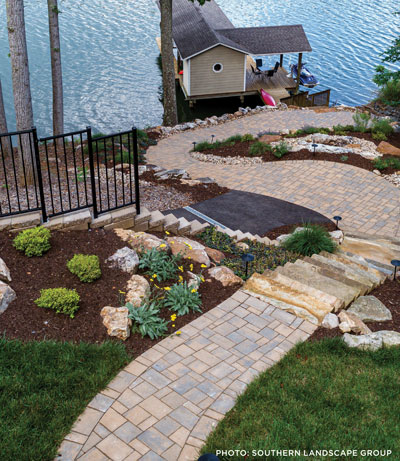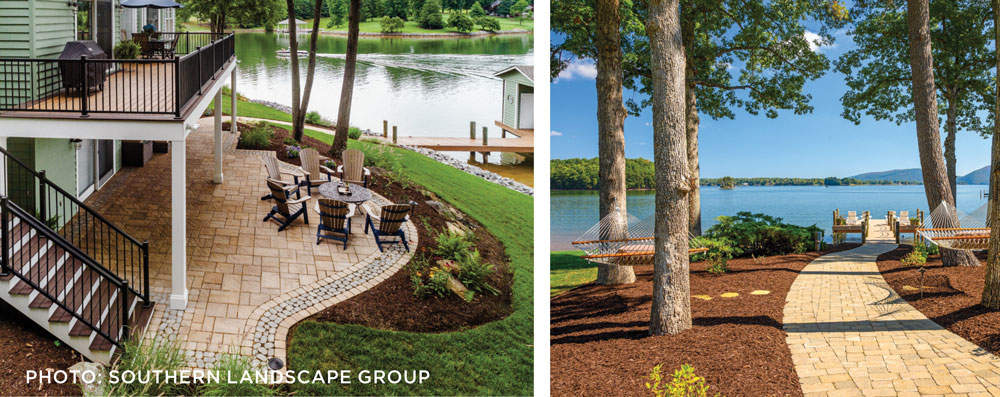Lakefront homeowners at Smith Mountain Lake enjoy soothing views of rippling water and lush vegetation. By implementing thoughtful landscaping on your own property, you can create appealing scenes that can enhance your shoreline, increase the value of your property, and protect the lake itself.
 Gardening at Smith Mountain Lake is much like gardening elsewhere. Property owners need to consider soil alkalinity, drainage and light exposure. Alkalinity is an easy DIY test, found at any store that sells gardening supplies. Drainage can be tested with meters as well, but this is often evident, with areas at lower levels typically wetter. Light exposure requires some thought, as the sun shifts both during the day and through the seasons. Light exposure also can change as trees or bushes reach maturity and cast longer shadows.
Gardening at Smith Mountain Lake is much like gardening elsewhere. Property owners need to consider soil alkalinity, drainage and light exposure. Alkalinity is an easy DIY test, found at any store that sells gardening supplies. Drainage can be tested with meters as well, but this is often evident, with areas at lower levels typically wetter. Light exposure requires some thought, as the sun shifts both during the day and through the seasons. Light exposure also can change as trees or bushes reach maturity and cast longer shadows.
For homeowners lucky enough to have a lakefront lot, an additional consideration is the authority American Electric Power (AEP) has up to what is known as the 800-foot contour.
When the Roanoke River was dammed in 1963, creating both Smith Mountain and Leesville lakes, AEP was licensed by the Federal Energy Regulatory Commission to operate the resulting Smith Mountain Project for energy generation. The normal pond elevation of Smith Mountain Lake is 795 feet, but AEP controls the shoreline of the lake up to the 800-foot elevation. This means a permit is required for any modifications to shoreline rip-rap, boat docks, and vegetation with a trunk diameter of a half-inch or greater up to the 800-foot mark on a property. Where that line falls depends on the property itself.
While basic gardening—the planting of annuals or an herb or vegetable garden—is allowed anywhere on the property, the removal of significant bushes or trees requires a plan for replacement, as erosion is a significant issue around the lake, where most properties have a significant slope.
“The best thing to do is to go to AEP’s website and follow their guidelines,” says Ronnie Mitchell of Ronnie Mitchell and Son Landscaping and Lawncare.
 Mitchell says water control and erosion are the most prevalent challenges he sees at the lake, noting that hardscaping slopes—retaining walls and drainage systems—can help manage runoff while grass is effective at absorbing water. He often recommends hard fescue, which is relatively low maintenance.
Mitchell says water control and erosion are the most prevalent challenges he sees at the lake, noting that hardscaping slopes—retaining walls and drainage systems—can help manage runoff while grass is effective at absorbing water. He often recommends hard fescue, which is relatively low maintenance.
“It grows to height and then lays over,” Mitchell says. “You have to maintain it with spray and fertilizer, and it can be shaggy, but you only have to mow it a couple of times.”
Galen Layman, project manager for Seven Oaks Landscapes-Hardscapes, agrees that grass provides significant erosion control and allows families to enjoy their lawns for games or social gatherings. “Grass is the cheapest and easiest to maintain over the long term,” he says.
With clay soil prevalent around the lake, adding lime will loosen the dirt, making it easier to work with, and drainage systems will help move water away from the surface quickly, mitigating erosion. Native plants are also recommended, as they are naturally adapted to the area. For small trees and bushes, Layman suggests viburnum, serviceberry, sweet spire and cardinal flower, all of which will bring color to the lot and, except for cardinal flower, scent. Larger trees would include river birch, redbud, fringe tree and the Virginia state tree, dogwood.
Layman cautions, however, that consideration of mature height of anything planted is essential.“People pay a premium for their lake view,” he says. “When trees get tall, that’s an issue. You need to be thoughtful about protecting the sight line.”

It’s not impossible to remove larger trees, Layman says, but it’s better to select carefully from the beginning, choosing trees and bushes that won’t grow to interfere with the scenery in the distance. “If you remove any plant larger than half an inch diameter up to the contour line on the lot, you’re asking for AEP to get involved,” he says, noting that AEP makes site visits to properties that are changing hands to ensure compliance with their regulations. “Before you close [on the sale], pretty much whatever they ask for will be done.”
Both Layman and Mitchell note that a professional landscaper will be able to identify issues on the property and help devise solutions, whether those are installed by a company or by someone with the time and energy to do it themselves.
An additional option at the lake is to call on the Buffer Landscape Committee of the Smith Mountain Lake Association, an all-volunteer nonprofit group dedicated to the enjoyment and preservation of the lake for all, owners and visitors alike. Any lake landowner can contact the committee to arrange for an on-site meeting with a master gardener or master naturalist. After an assessment of the lot and discussion of the homeowner’s goals, a plan will be prepared suggesting environmentally sensitive plantings, often in a buffer garden at the shoreline.
“Years ago, homeowners were told the best way to control erosion was to plant grass,” says Bob Hastings, who has owned property at the lake since 1998. “Whatever is put on that grass— fertilizer, herbicides, pesticides—flows into the lake. If we continue to dump [chemicals] in the grass, we’re going to kill the lake.”
Hastings notes that phosphorus levels at the lake from 2012 to 2019 have risen more than 200 percent, which is “very troubling,” because fertilizers without phosphorous are available. He says it’s not about eradicating grass—which he has on his lot—but about managing the grass safely and installing plantings at the shoreline that will absorb much of what runs off the grass. “If you’re going to invest in your grass, you’re going to have to invest in your buffer garden,” he says. “If your buffer garden doesn’t do what it’s going to do, you’re going to have a problem.” ✦
